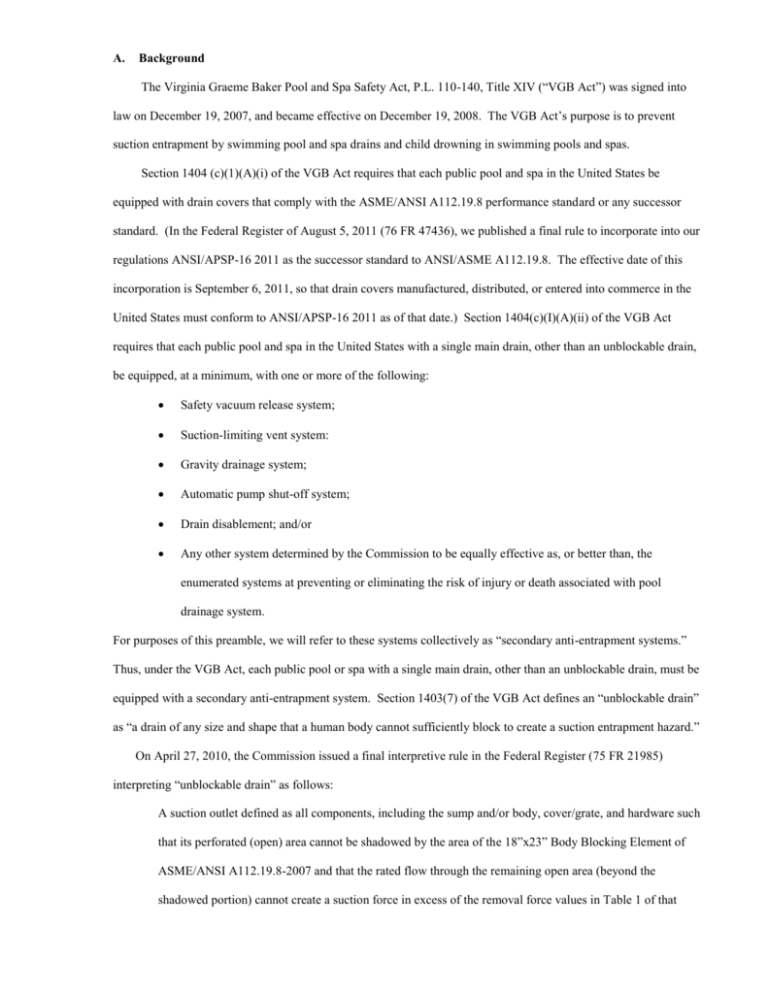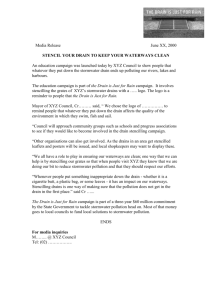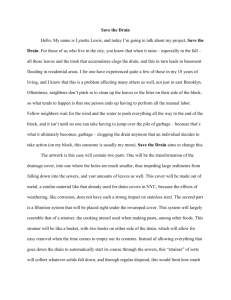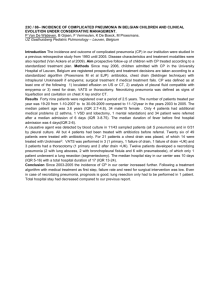Background The Virginia Graeme Baker Pool and Spa Safety Act
advertisement

A. Background The Virginia Graeme Baker Pool and Spa Safety Act, P.L. 110-140, Title XIV (“VGB Act”) was signed into law on December 19, 2007, and became effective on December 19, 2008. The VGB Act’s purpose is to prevent suction entrapment by swimming pool and spa drains and child drowning in swimming pools and spas. Section 1404 (c)(1)(A)(i) of the VGB Act requires that each public pool and spa in the United States be equipped with drain covers that comply with the ASME/ANSI A112.19.8 performance standard or any successor standard. (In the Federal Register of August 5, 2011 (76 FR 47436), we published a final rule to incorporate into our regulations ANSI/APSP-16 2011 as the successor standard to ANSI/ASME A112.19.8. The effective date of this incorporation is September 6, 2011, so that drain covers manufactured, distributed, or entered into commerce in the United States must conform to ANSI/APSP-16 2011 as of that date.) Section 1404(c)(I)(A)(ii) of the VGB Act requires that each public pool and spa in the United States with a single main drain, other than an unblockable drain, be equipped, at a minimum, with one or more of the following: Safety vacuum release system; Suction-limiting vent system: Gravity drainage system; Automatic pump shut-off system; Drain disablement; and/or Any other system determined by the Commission to be equally effective as, or better than, the enumerated systems at preventing or eliminating the risk of injury or death associated with pool drainage system. For purposes of this preamble, we will refer to these systems collectively as “secondary anti-entrapment systems.” Thus, under the VGB Act, each public pool or spa with a single main drain, other than an unblockable drain, must be equipped with a secondary anti-entrapment system. Section 1403(7) of the VGB Act defines an “unblockable drain” as “a drain of any size and shape that a human body cannot sufficiently block to create a suction entrapment hazard.” On April 27, 2010, the Commission issued a final interpretive rule in the Federal Register (75 FR 21985) interpreting “unblockable drain” as follows: A suction outlet defined as all components, including the sump and/or body, cover/grate, and hardware such that its perforated (open) area cannot be shadowed by the area of the 18”x23” Body Blocking Element of ASME/ANSI A112.19.8-2007 and that the rated flow through the remaining open area (beyond the shadowed portion) cannot create a suction force in excess of the removal force values in Table 1 of that Standard. All suction outlet covers, manufactured or field-fabricated, shall be certified as meeting the applicable requirements of the ASME/ANSI A112.19.8 standard. This language is codified in 16 CFR § 1450.2(b). Under this interpretation, when a drain cover meeting certain specifications was attached to a drain, the covered drain constituted an “unblockable drain.” As an unblockable drain, this drain did not require a secondary anti-entrapment system. For the reasons set forth in Part B, the Commission is clarifying this interpretation. As a result, a blockable drain cannot be made “unblockable” by use of a cover alone. B. Revised Interpretation Since the issuance of this interpretive rule, we received 156 letters asking us to reexamine our interpretation of the definition of “unblockable drain.” In general, these letters assert that drain covers, regardless of their size, can come off or break over the course of the life of a pool or spa, even when the owners and operators have the best intentions. They claim that for this reason, backup systems are necessary, and a swimming pool or spa with a single main drain cannot be made “unblockable” by the simple installation of a drain cover meeting certain requirements. They also claim that our interpretation of the definition of “unblockable drain” undermines the law’s intent of incorporating several layers of protection into pools and spas. These letters have been made part of the docket. In light of these letters, we are clarifying our interpretation of an “unblockable drain,” at 16 CFR 1450.2(b). The clarification is as follows: Where a single main drain exists and an “unblockable” cover is installed over a blockable sump and/or body, the outlet is a blockable drain. Per the April 27, 2010 interpretive rule for an unblockable drain, a suction outlet includes all components, including the sump and/or body, cover, grate and hardware. Therefore, a suction outlet is not defined by its cover alone, the sump and/or body must be included. If a suction outlet is a blockable drain then it may not be “unblockable” via the installation of an unblockable cover alone. All provisions of the VGB Act for a blockable drain shall be applied including a secondary means of entrapment release. C. Effect of Clarification of 16 CFR 1450.2(b) The clarification of this rule means that the installation of an unblockable drain cover can no longer be used to convert a blockable drain into an unblockable drain. Pursuant to the VGB Act, drains that are blockable require a secondary anti-entrapment system. Section 1404(c)(I)(A)(ii) of the VGB Act. Accordingly, if you have used an unblockable drain cover to create an unblockable drain, the clarification of the interpretative rule means that you must equip your public pool or public spa with a secondary anti-entrapment system as required by the VGB Act. A drain is “unblockable” if the suction outlet, including the sump, has a perforated (open) area that cannot be shadowed by the area of the 18” x 23” Body Blocking Element of ANSI/APSP-16 2011 and the rated flow through any portion of the remaining open area (beyond the shadowed portion) cannot create a suction force in excess of the removal force values in Table 1 of the Standard. The Staff Technical Guidance of June 2008 will be updated to clarify that placing a removable, unblockable drain cover over a blockable drain does not constitute an unblockable drain. This clarification corrects the previous interpretation, which the Commission now believes was in error and thwarts the intent of the law to require layers of protection in cases where a drain is blockable and presents an entrapment hazard. The Commission has set a compliance date of May 28, 2012, to allow time for firms that require modifications as a result of this clarification to bring their pools into compliance with the statute as written. List of Subjects in 16 CFR Part 1450 Consumer protection, Infants and children, Law enforcement. For the reasons stated above, the Commission amends part 1450 of title 16 of the Code of Federal Regulations by removing section 2(b) as set forth below: PART 1450 – Virginia Graeme Baker Pool and Spa Safety Act Regulations 1. The authority citation for part 1450 continues to read as follows: Authority: 15 U.S.C. 2051-2089, 86 Stat. 1207; 15 U.S.C. 8001-8008, 121 Stat. 1794. § 1540.2 Definitions. ***** (b) [Removed] Dated: _____________________________ Todd A. Stevenson, Secretary Consumer Product Safety Commission




